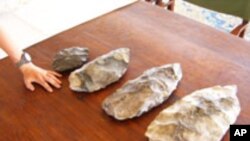While scientists today are trying to determine the full effects and causes of ongoing climate change, it's not the first time the earth has experienced such changes. For example, in what is now Botswana's Kalahari Desert, a giant dry lake bed is revealing clues to ancient weather and how early man adapted.
Oxford University Professor David Thomas says Lake Makgadikgadi was big – very big. Something he calls a mega-lake.
"At its largest extent, a lake that was 60,000 square kilometers in area…about the same size as Lake Victoria. So, it's a pretty big lake, varying in depth, but many tens of meters deep. And a lake that clearly is the size of a small inland sea. So in windy conditions you'd have stormy conditions on it," he says.
The lake grew, shrank, disappeared and grew again over the last 250,000 years depending on the climate and rainfall.
Thomas and his colleague Sallie Burrough say the lake bed is revealing how people there lived, especially in the Middle Stone Age – beginning about 110,000 years ago and ending some 50,000 years ago.
"The Middle Stone Age is when us, as in our anatomically modern humans, evolved. So this isn't about some deep ancestor. This is our direct ancestors and how they used this environment," he says.
Tools for the taking
On the lake bed, they found tens of thousands of small stone tools and some very big ones.
<!-- IMAGE -->"We have here a small number of giant hand axes. They're 12 inches long (30.5 Centimeters). And they're very heavy as well. They're very unusual. They're probably the largest axes ever found," he says.
Exactly how those axes were used is a mystery. One possibility is that they were used as raw material from which smaller tools were made. Or maybe they were just symbolic.
"Something to do with fertility or even it's been suggested something like a shop sign. Another alternative is they're practice pieces – the sort of things you showed people to teach them how to make a stone tool. So they're very, very debatable and contentious in terms of what they mean," he says.
And since the ancient axes are heavy, it's unlikely they'd be carried by hunters in pursuit of their prey.
But what's also significant is that the axes and many tools were found on the lake floor, not along what would have been the shoreline.
"What it really means is that the lake was very, very important to people, not so much when it was a big, permanent lake, but when it had seasonal water in it," he says.
Why is that important?
"If have a lake basin that seasonally has water in it, which is the case today, it becomes a very important location because of course animals going to where water was available," he says.
<!-- IMAGE -->The animals would concentrate around watering holes when the lake was low. So, as the climate changed, so did hunting habits.
"People were opportunistic. They were using the environment, taking the resources that were available and moving according to where those resources were," says Thomas.
What's more, when Lake Makgadikgadi was a mega-lake, it may have been used as part of the route humans took to exodus Africa for Europe and elsewhere. That's a possibility being studied.
Today, political boundaries and the huge increase in population prevent such mass migrations from happening again.
<!-- IMAGE -->Oxford researchers are also studying the tools to determine where the people traveling through the lake region came from. How the tools were made could indicate whether they came from the tropical parts of the continent or from what is now South Africa.
So, if the lake has appeared and disappeared many times over the course of 250,000 years, could it come back yet again?
"It could come back for two reasons. One is if you have more rain in the catchment area that would feed the rivers that would drain into the basin. But the other thing is, once you start to get a big lake it actually starts to affect its own regional climate. Because you've got a big body of water that when it's warm can supply moisture to the atmosphere. And then it becomes s self-feeding system. So, yeah, it certainly could come back," he says.
New research is also set for next year to determine if the lake basin was once linked to the Zambezi River.
<!-- IMAGE -->









